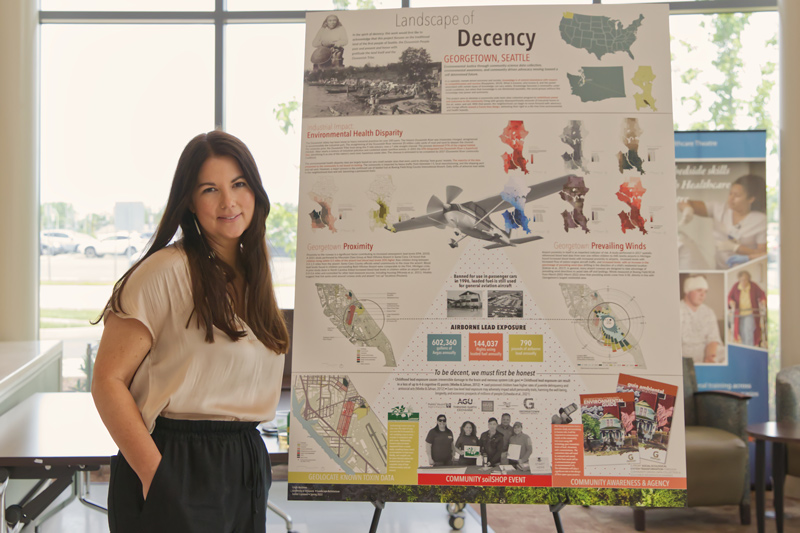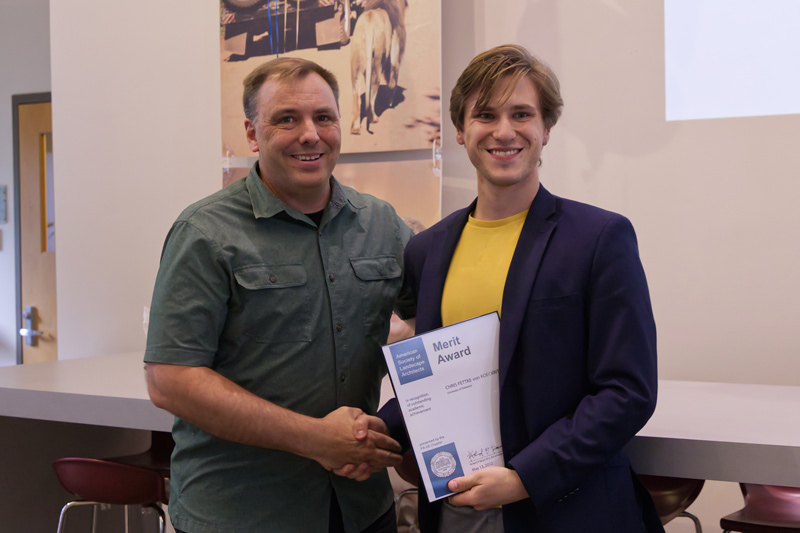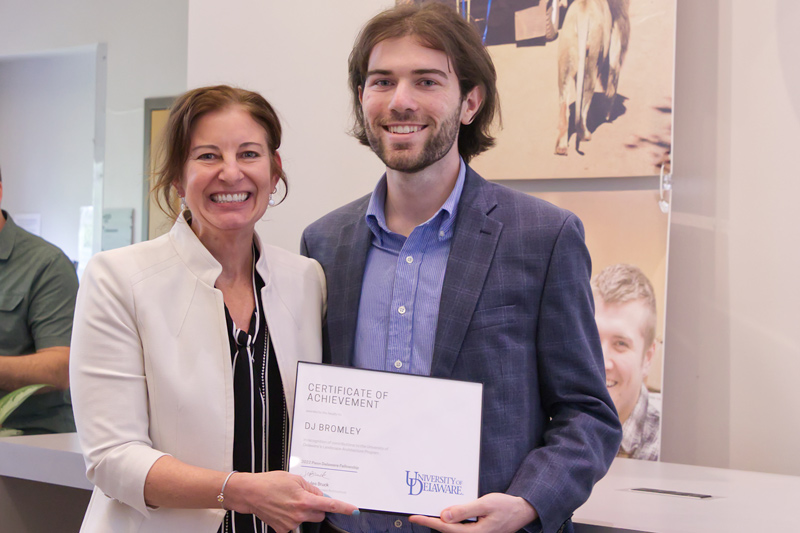

Three students discuss landscape architecture courses at UD: youtube.com/watch?v=T7i3GwhKm8M
Rising stars in landscape architecture
Photos by Monica Moriak August 15, 2022
UD courses and research experiences help landscape architecture majors hone post-graduation plans
As caps were tossed and tassels turned in late May, three University of Delaware seniors officially concluded their very busy, yet very rewarding final semester in UD’s unique bachelor of landscape architecture program.
After spending many hours in Townsend Hall’s senior design studio, Leigh Muldrow, Christopher Fettke von Koeckritz and DJ Bromley’s walked across the convocation stage was a major step in their young careers in landscape architecture, a fascinating field at the intersection of art, plants, ecosystems and site design. The undergraduate experience of these newly minted UD alumni led to exciting graduate school plans in Philadelphia, Oslo and Newark.
All three Blue Hens interned at UD’s Coastal Resilience Design Studio (CRDS), which focuses on evolving coastlines in Delaware. The research group works with cities and towns to adapt to environmental change. The experience showed them the unique, meaningful role that landscape architects can play in a community.
In the classroom, Department of Plant and Soil Sciences faculty asked each senior to choose a site across the globe for their capstone project. Muldrow was drawn to Seattle, Washington, and Fettke von Koeckritz landed on Kotzebue, Alaska; Bromley envisioned a broader topic, thinking theoretically about landscape architecture at large. Their experiences and original approaches to design led to three very different proposals.

The achiever
As a student returning to college to pursue a career change, Muldrow’s background in business and economics helped shape her decision to pursue landscape architecture. In her senior project, she focused on soil toxicity and its impact on surrounding communities. Muldrow questioned the delicate conversations of telling people living in toxic environments the truth about their situation.
“In my case, it’s going to be designing this community-wide soil sampling event in conjunction with the state of Washington and their toxicology department,” explained Muldrow. “We would provide soil data for their entire community so that we can identify hotspots, and then that will lead to design implementation.”
Muldrow is conducting ongoing research in the Georgetown neighborhood of Seattle, doing community science data collection as a mechanism for environmental justice. Georgetown faces a difficult battle with pollution, which Muldrow and her research team analyze with support from the American Geophysical Union (AGU) Thriving Earth Exchange. She is focused on the effects of pollution on the community and nearby Duwamish River as a result of local factors like a large interstate rail yard and, most importantly, a neighboring airport.
“The fact that piston-engine airplanes are still using leaded fuel, even though leaded fuel has been banned in every other way, is really placing an unfair, daily burden of exposing this community to airborne lead particles,” said Muldrow, who is from Milford, Delaware.
Muldrow was recently named the recipient of the Landscape Architecture Foundation’s Olmsted Scholar Award for her work; the honor is given to students who exhibit a commitment to landscape architecture, leadership and advancing sustainable design.
In the fall, Muldrow will remain at UD to pursue a doctorate in Plant and Soil Sciences.

The adventurer
Like Muldrow, Fettke von Koeckritz investigated the impact of landscape architecture on a community. He set his sights north, 26 miles above the Arctic Circle, where he searched for solutions to environmental challenges faced by Kotzebue, Alaska.
“Kotzebue is experiencing challenges exacerbated by climate change,” Fettke von Koeckritz said. “Alaska is the only coastal state in the U.S. that does not have an organized coastal management program.”
This project took into account both the environmental impacts of these challenges and the impact on the inhabitants of the community. Fettke von Koeckritz investigated these issues; he wanted solutions that honored the community, its traditions and its people in a respectful manner. He worked to tread lightly on the actual landscape while helping to solve erosion problems brought on barrier islands created out of dredge material.
The project led him to another cold-weather destination — graduate school at The Oslo School of Architecture and Design in Norway, where he’ll receive hands-on experience researching arctic environments.
Fettke von Koeckritz is champing at the bit to visit the Arctic in-person with his Oslo professors and graduate cohort.

The theorist
While Muldrow and Fette von Koeckritz were working alongside specific communities, Bromley was curious about the big picture. How can landscape architects use their unique education to impact communities as a whole?
He observed patterns ingrained within the field that marginalize groups of people and perpetuate inequities in society. The end result was a re-evaluation of the educational system for landscape architects. Bromley urged the profession to continue evolving its instruction.
Bromley’s technical adviser was Zachery Hammaker, a UD instructor and University of Pennsylvania graduate. Hammaker encouraged Bromley to apply for the Penn/Delaware Graduate Fellowship, an esteemed opportunity for landscape architecture majors to apply to Penn’s Master of Landscape Architecture program.
Bromley’s strong resume and portfolio earned him admission and a scholarship to the school’s prestigious, three-year program.
“There are a lot of practices and techniques and tricks in the field that have originated [at Penn], so I’m really excited to be able to head up there and study,” said Bromley, who is from Wilmington, Delaware.
Like the rest of their cohort, these UD Class of 2022 landscape architecture majors capitalized on the hands-on research and design experiences during their time in Newark.
“There is something very special about having a landscape architecture program in a plant and soil sciences department in a college of agriculture because we’re very close to the land,” said Jules Bruck, former UD professor and founding director of the bachelor of landscape architecture program. “Our students highly value the land; they understand the landscape at a deep level when they graduate because they get a really good education on it.”
Contact Us
Have a UDaily story idea?
Contact us at ocm@udel.edu
Members of the press
Contact us at 302-831-NEWS or visit the Media Relations website

